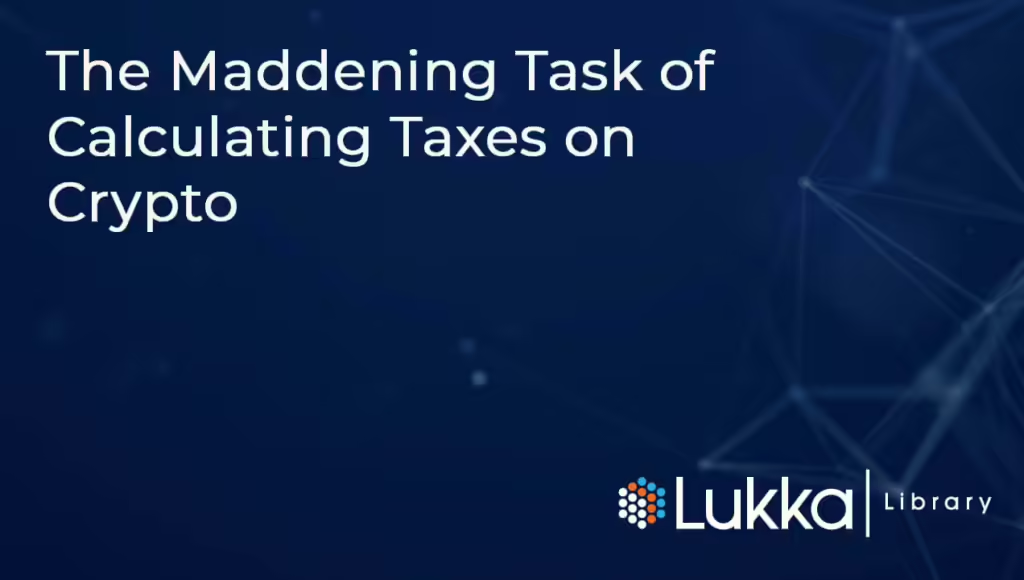For many in Cryptoland, “decentralize everything” is a common mantra. And, it’s something I personally believe in, to a point.
However, for various business processes that require aggregated data to execute, decentralization creates problems that are very challenging for individuals and enterprises to navigate.
Case in point: tax compliance.
Now, this is not a sexy topic and probably something you might wish to skip entirely. But, we all know the saying about death and taxes, so let’s be adults and understand why this really is a thing in our industry.
First, it’s important to recognize calculating tax exposure means executing a data-heavy business process. Now, in the normal world, when dealing with non-crypto assets, this process is pretty clean with most of the friction largely abstracted away, making it easier to calculate tax and for Uncle Sam to get paid.
However, in Cryptoland, much of the efficiency we take for granted doesn’t exist. Which means the taxpayer has to muscle through a very challenging data exercise.
So, in an effort to shine some light on why this is a big challenge for taxpayers, here’s a taste of the complexity taxpayers must go through to pay their fair share. I sincerely hope that regulators and politicians, who might just assume this is all so simple, are paying attention.
That’s a mouthful.
First, to make the process easy to remember, let’s create an acronym that represents all the steps a taxpayer must execute: FIETFCCAPRSE.
Rolls right off the tongue, right?
Ok, so here goes. The taxpayer must:
- Find the data. Not easy, as there are now more than 170 crypto exchanges worldwide, with more than one opening a week and that doesn’t even include over-the-counter venues and forthcoming decentralized exchanges.
- Isolate the data. Tough, because many data elements are not exactly the same, even though they have the same name, so it’s hard to know what’s the right data element. For example, does “output amount” mean exactly the same thing across all venues?
- Extract the data. Again, tough because certain crypto exchanges limit your ability to extract historical data (I’m looking at you, Bittrex) or apply limits once you’ve hit certain transaction volumes.
- Transport the data. This is more of a problem for enterprises that try to programmatically pull out data from APIs, as they very quickly find that the data highways are constantly under maintenance or shut down.
- Format the data. Now that the taxpayer has a bunch of files, they quickly discover that none of them look the same. Getting them into the same format can require some serious spreadsheet-jockeying skills.
- Check the data. Hmmm… something doesn’t look right. Is the taxpayer missing transactions? Time to call an 800 number for help. Oh wait, there aren’t any.
- Correct the data. This is challenging as most taxpayers are not tax professionals. What to correct and why? How do I know I even have the correct information to start with?
- Aggregate the data. Now the taxpayer needs to consolidate it all into one file… time to power up Google Sheets again.
- Process the data. Time to do the matching: This gain goes with this loss. Wait, should the taxpayer choose the “first in, first out” method for the cost basis, “last in, first out” or average cost? How to manage partial lots?
- Reconcile the data. How can the taxpayer be sure that the processed data is complete and accurately associated with the trades collected from all of their trading venues?
- Store the data. Where should the taxpayer store the data that’s safe and secure, as the IRS might want to take a look at this sometime over the next 6 or 7 years.
- Export the data. Now the taxpayer needs to take all that processed, accurate, and complete data and convert it into the proper format and export into a form that they can send to the tax authority. Along with a check. (Sorry, no crypto payments in the U.S. right now – though Arizona’s working on it.)
Suffice to say, for most taxpayers this is madness.
There are big potholes at every turn, with the outcome either being lack of compliance, or paying tax but having absolutely no clue if it was the right amount.
Finding solutions.
So, what’s the answer?
Well, first, regulators and politicians need to understand how complex this process is and not default to the point of view that any lack of compliance is coming from a complete lack of willingness to pay. I’m talking to you here Rep. Brad Sherman.
Certainly, there are some who are looking to cheat, but our experience is that individuals and organizations want to comply but need the guidance, tools, and services providers to do so.
Second, trading venues should adopt standard data and reporting processes in order to support the collection and distribution of transactional data for tax purposes.
Third, taxpayers, individuals and enterprises alike, have to find service providers with the right tools and understanding. This way they can quickly move on to activities they actually enjoy.
In summary, this stuff is seriously not easy and worse, it takes a lot of time and money just to get to a point where you might have calculated the correct amount of tax.
However, on the brighter side, if you look around there are companies and service providers that are building tools and offerings to help. (Full disclosure: my company is one of them.)
So be proactive and search for help. But remember, just because this is hard, or you’re not schooled up for the task, that is decidedly not an excuse for non-compliance.
You must take this stuff seriously, because you absolutely don’t want to get a letter from the IRS saying “Hi, you’re being audited.”



